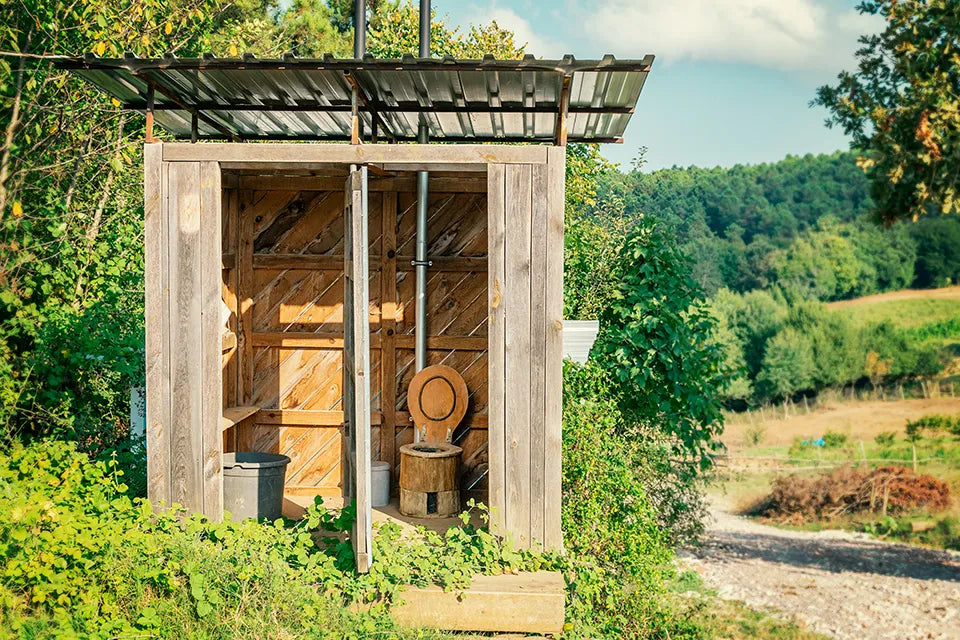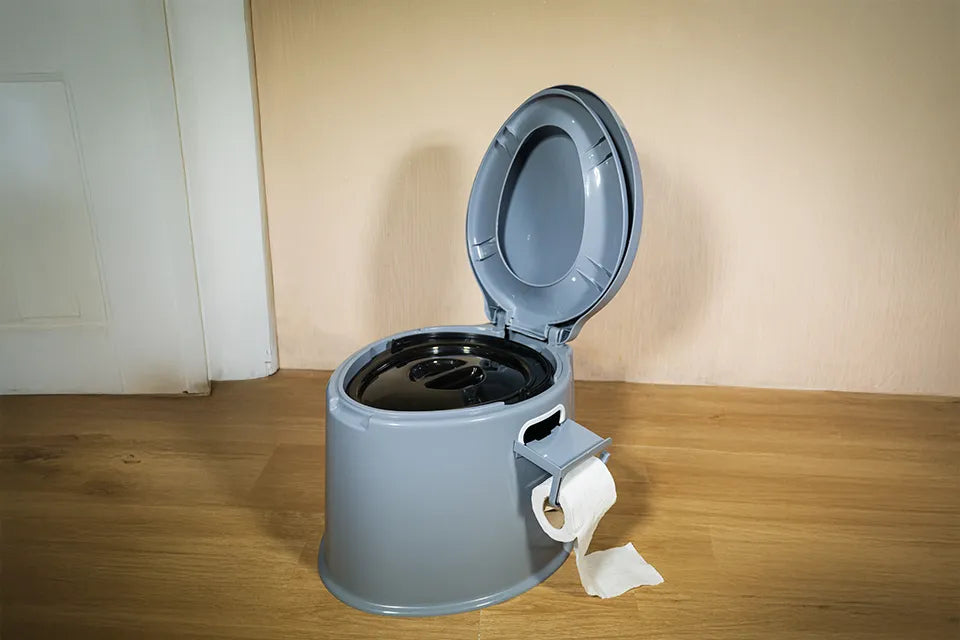Dry toilet terminology
Are all dry toilets the same?
When exploring alternative toilet systems, you may come across terms like urine diverting dry toilet and composting toilet thrown around as if they mean the same thing. But hold on – while the these options definitely share some characteritics, there's more than meets the eye. Let's break down the most common dry toilet terms:
- Urine diverting dry toilet – This system separates liquid from solid waste, storing each in dedicated containers. The absence of water deems it a dry toilet, while you always have the added option to compost solid waste as long as you make sure that you use a compostable inlay in your solids container.
- Composting toilet – Focused on waste recycling, composting toilets let you convert human waste into nutrient-rich compost. Some composting toilets allow you to start the composting process of the toilet waste directly inside the toilet.
- Dry flush toilet – This self-contained, waterless system uses a liner to individually wrap and seal waste after each use. It requires no plumbing or composting and is ideal for mobile or temporary setups where convenience and odor control are key.
- Dry toilet – Broadly speaking, any toilet not reliant on water can be classified as a dry toilet. This category may or may not incorporate a mechanism for waste separation.
As we can see, there are quite a few overlaps. A urine diverting dry toilet may serve as a composting toilet and is a type of dry toilet. Similarly, a dry flush toilet also falls under the dry toilet category but doesn’t rely on composting or urine separation. However, not every composting or dry toilet is necessarily a urine diverting or dry flush toilet.
Additionally, you might encounter terms like urine diverting toilet, separating toilet, separation toilet, or separating dry toilet – all essentially describing a urine diverting dry toilet.
In the next sections, we'll closely compare urine diverting dry toilets, composting toilets, and dry toilets without separating mechanisms to understand what sets each system apart.
Pros and cons
What is the best dry toilet system?
To grasp the nuances of alternative toilet systems, it's important to take a closer look at their features. Each system offers a unique set of advantages – be it the comfort of urine diverting dry toilets, the recycling capabilities of composting toilets, the convenience and cleanliness of dry flush toilets, or the simplicity of dry toilets overall. Understanding these differences is crucial to making an informed decision perfectly aligned with your lifestyle.
Urine diverting dry toilet – The perfect all-rounder
A urine diverting dry toilet offers numerous advantages with its efficient separation of liquid and solid waste, storing them in designated containers. The liquids flow into a specific container, while the solids are deposited in a separate container protected by an inlay.
This separation of urine and feces not only significantly reduces the odor, but it also allows for the complete elimination of unpleasant smells, either by using litter or an electric exhaust system. The lack of water dependency makes this solution highly versatile and usable in various locations without the need for a sewage system connection.
Cleaning the urine diverting dry toilet is a breeze as well. The solids container, shielded by an inlay, requires minimal cleaning as there's no direct contact with the feces. It can simply be rinsed with water from time to time, similar to the liquids container. Thanks to the effective separating system, concerns about excessively dirty surfaces are eliminated.

Additionally, emptying the toilet waste is both easy and hygienic. You can conveniently remove the liquids and solids containers separately as needed. For those interested in composting, solid waste can be transformed into a valuable resource using a composter, while liquid waste serves as a natural fertilizer. If composting isn't preferred, the disposal remains hassle-free as the inlay with solid waste can be easily discarded with household waste, similar to used diapers. Meanwhile, the collected urine can be poured into a regular toilet.
Another noteworthy advantage of the urine diverting dry toilet is that you can simply deposit your toilet paper in the back of the toilet, just like with a regular toilet. The only consideration is using eco-friendly toilet paper without colors or scents if you wish to compost the toilet waste.
Pros:
- Efficient separation of liquid and solid waste
- Significantly reduces or eliminates odor
- Works without water or sewage connection
- Easy and hygienic emptying
- Minimal cleaning effort due to inlay
- Toilet paper can be disposed of in the toilet
- Suitable for many locations
Cons:
- Requires use of eco-friendly toilet paper for composting
Composting toilet – An option for composting enthusiasts
As mentioned earlier, a urine diverting dry toilet can also function as a composting toilet, allowing for easy disposal of toilet waste into a composter. However, there exists another type of toilet specifically designed to initiate the composting process directly within the toilet itself.
This particular composting toilet is equipped with a specialized stirring device, known as an agitator, which enhances the composting process. Whether operated manually or electrically, the agitator facilitates effective aeration, accelerating decomposition and minimizing odors.
It's crucial to note that composting any organic material takes a considerable amount of time, ranging from a few months to several years. Therefore, completing the entire composting process within the toilet is not the standard practice. Instead, the agitator's stirring function initiates a pre-composting stage for solid waste. When it's time to empty the solids container, the pre-composted waste still needs to be transferred to a regular composter. For mobile composting toilets on longer trips, where transferring waste to a composter may not be feasible, pre-composting offers little benefit.

A significant drawback of composting toilets with an agitator is the removal of solid waste, which is more complex and less sanitary compared to a urine diverting dry toilet. The absence of a protective inlay for the solid waste container means direct contact with excrements, making regular, deep cleaning highly necessary. The cleaning process, including removing bits from the agitator, can be extremely messy. Moreover, some models require complete removal of the agitator during the container cleaning.
Unlike urine diverting toilets, putting any type of toilet paper into the solids container is not feasible with composting toilets with an agitator. Meaning, a separate storage for used toilet paper is required, adding another inconvenience compared to the user-friendly design of a urine diverting dry toilet.
Finally, composting toilets with an agitator tend to be relatively expensive when compared to urine diverting dry toilets and other types of dry toilets.
Pros:
- Begins the composting process directly in the toilet
- Agitator improves aeration and reduces odor
Cons:
- Composting process is slow and incomplete within the toilet
- Complex and messy emptying process
- Requires regular and deep cleaning
- No inlay - direct contact with waste
- Agitator parts can be difficult to clean
- Toilet paper must be disposed of separately
Dry flush toilet – A low-maintenance option for short-term use
Dry flush toilets are a convenient, waterless solution that prioritize hygiene and simplicity. Designed for mobile or temporary setups, they use a battery-powered or electric mechanism to wrap and seal waste in a special liner after each use. The result is an odorless, touch-free system that requires no plumbing, composting, or waste separation.
Thanks to their fully self-contained design, dry flush toilets are incredibly easy to install and operate. Once the cartridge - the sealed unit that holds the special liner or bagging system - is full it can be removed and disposed of with regular trash. This makes them especially attractive for occasional use in camper vans or tiny houses.
However, the ease of use comes at a cost. The need to regularly purchase and replace the cartridges makes dry flush toilets a more expensive and less sustainable long-term option. Additionally, the sealed plastic waste cannot be composted, which may be a drawback for those looking for an eco-conscious solution.
Compared to urine diverting dry toilets, which separate waste at the source and offer the option to compost solids with minimal mess, dry flush toilets fall short in terms of sustainability and cost-effectiveness. While they offer a convenient alternative for short-term needs, they lack the long-term environmental and economic benefits of a well-designed urine diverting system.
For those seeking a clean, efficient, and environmentally responsible toilet solution, the urine diverting dry toilet remains the most well-rounded and versatile choice.
Pros:
- No plumbing or composting required
- Hygienic sealed waste system
- Ideal for mobile or short-term setups
Cons:
- Requires ongoing purchase of expensive cartridges
- Generates plastic waste
- Lacks waste separation and eco-friendly options
- High purchasing and running costs
Dry toilet – For those who love simplicity
After examining the features of a urine diverting dry toilet, which carefully separates liquid and solid waste, let's turn our attention to a simpler dry toilet – a dry toilet that combines all waste in one bucket. This straightforward setup, reminding of a basic outhouse with a small bucket beneath the toilet seat, is easy to comprehend.
However, there are serious downsides. Since urine and feces are stored together in a single container, unpleasant toilet smells are unavoidable. It's important to note that the separation of liquid and solid waste is crucial for preventing odors. With the rapid onset of unbearable smells, frequent emptying becomes a necessity, constituting a significant drawback in itself.

A more substantial downside emerges concerning the emptying process – where should the waste be disposed of? Composting is a potential option, but only if the ratio between liquid and solid waste is appropriate. Achieving the right composition can be challenging, complicating the composting process.
Last but not least, it's essential to acknowledge that cleaning the container of this type of dry toilet can be quite messy and not nearly as hygienic as cleaning two separate containers as with a urine diverting dry toilet.
Pros:
- Simple and easy to understand
- No need for complex systems or electricity
Cons:
- Strong odor due to combined liquid and solid waste
- Requires very frequent emptying
- Difficult and messy to clean
- No option for clean separation or easy disposal
- Complicated composting due to improper waste ratio
Conclusion
Which dry toilet system is right for you?
The urine diverting dry toilet stands out as the best option for most users. In contrast to toilets that store all waste in one single container, the urine diverting dry toilet maintains an odorless environment, is easily cleaned, and allows for effortless waste disposal. The freedom to choose between composting and conventional disposal adds to its flexibility.
For those dedicated to composting, a composting toilet with an agitator, designed for pre-composting solid waste, might sound interesting. However, it's crucial to carefully assess this advantage against significant drawbacks, including a difficult emptying and cleaning process for the solid waste container - all for a marginal reduction in the overall composting timeline, which could still extend over a year or more. An agitator is not indispensable for composting toilet waste, making a urine diverting dry toilet likely to remain a more comfortable, cost-effective, and overall superior choice.
Dry flush toilets, while clean and user-friendly in short-term scenarios, come with recurring costs and generate sealed waste that cannot be composted - limiting their appeal for long-term, environmentally conscious use.
Also, a dry toilet lacking a separating mechanism presents serious drawbacks, including rapid odor formation, challenging cleaning and emptying procedures, and complex considerations regarding waste disposal and composting.
In conclusion, a urine diverting dry toilet offers the optimal blend of advantages, providing comfortable, odorless toilet use without the need for water, and the option to compost waste.











